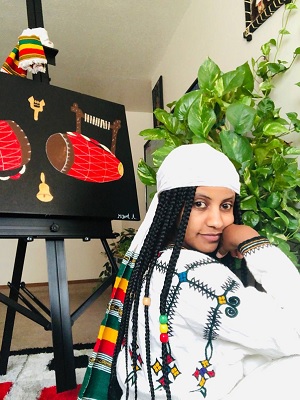
Disability from days of yore to current days is a global topic of concern that is affecting not only people living with disability but also societies in various ways. From ancient times to these days, misconceptions about such people in societies are not strange, for most traditional societies believe disabilities are the results of curses. As such, oblivious to the fact that disability is not inability, they wrongly consider people in this category as burdens to society. Meanwhile, due to the concerted efforts by governmental and International Organizations, there is a remarkable upturn in societies’ mind set of disability.
A talented painter with a compassionate heart, Mignot Getachew has channelled her artistic pursuit towards creating a positive impact in the lives of autistic children consecrating the major portion of her life to the passion. Tapping into her verve, capturing her imaginations and observations on canvas via her brushes and nimble hands and through her unique approach to painting, she has found a way to empower these children, helping them unleash their creativity and express themselves in ways that words often fail to depict.
Mignot’s work has not only touched the hearts of many families but has also spotlighted the incredible hidden abilities and potential of autistic individuals. The art column of The Ethiopian Herald has got her for interview. Excerpts
Could you brief us about your life as a painter and also about the ups and downs you navigated through?
My life as a painter is a lot more fun. I often focus on the bright side. I’m living my best life in the present because I do what I love the most. What else could gratify one than this? Art makes me happy. As part of life, the ups and downs are always there. Fortunately, I dare say I did not experience the downs much.
What motivated you to create paintings zeroing in on autistic children ?
Whether in individual or collaborative works, a sense of urgency is palpable in those pieces, a sense that the actual stories of people living with disability have been ignored, brushed aside, or diminished and therefore must be told. I have a client who owns autistic children center. So she needed a wall painting in the center .Mindful of this gap, I created the looked-forward piece. After I brought to life the painting I felt excited as autistic kids badly need art therapy. This approach is really good for their mental health and the way they are treated.
What messages do you encapsulate in your paintings?
I aim to convey a sense of awe, wonder, and peace. I want my paintings to evoke a sense of interconnectedness and joy, and to evoke feelings of elation, hope, and healing. I also want my paintings to be a reminder of the magnificence of the natural world and to inspire people to take action to protect it.
Have You assessed feedback from autistic children or their families about the impact of your paintings ?
I did assess the children’s turn around and received a feedback from their family members they are very happy about it. That has a big impact on the autistic community so they are very grateful for the work.
What advice do you give to aspiring painters who want to create art that highlights the secret of autistic children shrouded in mystery ?
My advice to who wants to create influence-wielding art is “go for it.” Do what makes you happy so that you will be successful. Follow your dreams and make it happen.
What are your future goals and aspirations for your work in terms of creating painting homing in on autism ?
My future goals are to come up with a multitude of impactful paintings. Even here in USA, specifically in the Ethiopian community, people do not have much information about autistic kids. As people could not get the required knowledge they need to know the idea could not sink in. So parallel to the sensitization task, I will continue to do more painting for autistic kids.
Let us talk about art therapy, what really is it?
Art therapy is a form of therapy that uses the creative process of making art to improve a person’s mental, emotional, and physical well-being. It can be an effective way for individuals to probe inward and explore their feelings, express themselves, and work through psychological issues. Art therapy can be used with individuals of all ages and backgrounds, making it a versatile and accessible form of therapy. It can be especially beneficial for people who have difficulty expressing themselves verbally, such as children or those with signs of developmental disabilities.
What could be the best approaches toward art therapy?
There are various approaches to art therapy, but the basic premise is that creating art can help individuals tap into their subconscious thoughts and emotions in a way that tradition al talk therapy cannot. By working with different art materials and techniques, individuals can explore their feelings and experiences in a non-verbal way, allowing for deeper insight and healing.
What are the things people in art therapy exactly do?
In art therapy sessions, a trained art therapist will guide individuals in using art materials such as paint, clay, or collage to create images or projects that reflect their inner thoughts and emotions. The therapist may also provide prompts or exercises to help individuals explore specific themes or issues.
Would you enumerate about the benefits of it?
One of the key benefits of art therapy is its ability to promote self-expression and self-discovery. Through creating art, individuals can gain insight into their own emotions and experiences, as well as develop a sense of empowerment and agency over their own mental health. In addition to its therapeutic benefits, art therapy can also be a fun and an enjoyable way for individuals to relax and create. The act of making art can be a meditative and calming experience, providing a welcome escape from the stresses of daily life.
How effective is it?
The impact of my work on autistic children has been remarkable. Through art, children who struggle to communicate verbally find a means to express their inner world. Painting becomes a transformative process, enabling them to communicate their joys, fears, and thoughts that may have otherwise remained trapped within them.
Beyond the therapeutic benefits, my art sessions instil a sense of accomplishment and confidence in the children. As they observe their creations taking shape, they develop a sense of pride, boosting their self-esteem and encouraging further exploration of their artistic abilities.
BY NAOL GIRMA
THE ETHIOPIAN HERALD FRIDAY 26 APRIL 2024




